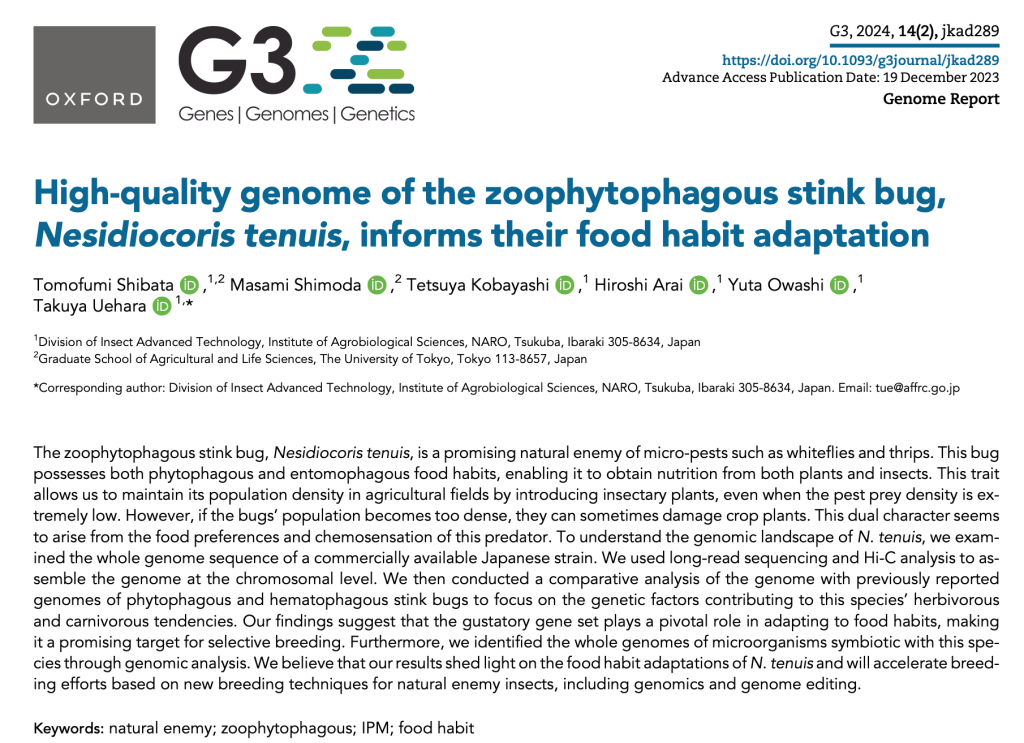修士2年柴田智文さんの論文が雑誌「G3: Genes|Genomes|Genetics」に掲載されました。
以下よりご確認いただけます。

G3 URL : https://academic.oup.com/g3journal/article/14/2/jkad289/7479702
【タイトル】
雑食性カメムシであるタバコカスミカメの高いクオリティゲノムとその食性について
High-quality genome of the zoophytophagous stink bug, Nesidiocoris tenuis, informs their food habit adaptation
【要約】
タバコカスミカメはコナジラミ類やアザミウマ類などの微小害虫の天敵昆虫として期待されている。
本種は上記のように肉食性をもつが、一方で植食性も持ち、このために密度が高まると農作物をも加害してしまうというデメリットも存在する。この問題点について生態学的な知見はあるが、遺伝学的な知見は大いに不足している。そこで、本研究では日本の系統についてOxford Nanopore Technologyを用いたlong-read sequencingとHi-C技術を組み合わせることで、1) 全ゲノム解析を行うとともに、2) その食性について考察を行った。
1) ではscaffold数が20、N50が16.4 Mb、BUSCOが94.6%のQualityのゲノムをアセンブリした。これは以前発表された本種のゲノムよりqualityの高いものとなっており、chromosome levelといえるものである。
また、同時に副産物として腸内共生菌の完全長ゲノムを得ることができ、ゲノム相同性よりN. tenuisがSpiroplasma (Molicutes) and Rickettsia (Alphaproteobacteria) の両方を共生していることを確認した。この腸内共生菌の解析においては農研機構所属の大鷲博士と新井博士に行っていただいた。
2)については植食性、雑食性、血液食性の近縁種と比較解析を行った。化学受容体に着目したところ、カスミカメグループ(Miridae)では味覚受容体に比べて、嗅覚受容体のファミリーのクレードが頻繁に観察された。これはMiridaeは共通の匂い物質のセットを受容していることを示唆している。
一方で、植食性を持つ種では味覚受容体の一部が比較的大きなクレードを形成しており、同様の植物揮発性物質を受容していることが示唆された。しかし、それぞれの種では食性に合わせて、より特異的なGRを要求する傾向にあるようである。
ゲノム編集技術が台頭している昨今、今回明らかになった連続性の高いhigh-qualityなゲノムはN. tenuisの生物学的機能や有益な形質の探索に貢献すると考えられる。
N. tenuis is a promising natural enemy of micropests such as thrips. This species exhibits both zoophytophagous and herbivorous behaviors, raising concerns about crop damage as its population density increases. Genetic insights addressing like this issue insufficient.In this study, we used Oxford Nanopore Technology for long-read sequencing combined with Hi-C technology to address two key objectives. Firstly, we conducted a whole genome analysis (1) and secondly, we investigated the species’ food habit adaptation (2).
1) We successfully assembled a high-quality 🧬 with 20 scaffolds, an N50 value of 16.4 Mb, and a BUSCO score of 94.6%. This assembly surpasses the previously reported genome for this species in terms of quality and can be considered at the chromosome level.
Additionally, we obtained complete 🧬 of symbiotic microorganisms as byproducts, confirming that N. tenuis hosts Spiroplasma and Rickettsia as endosymbionts through genome homology. We extend our gratitude to Dr. Owashi and Dr. Arai for their contributions to the analysis.
2) We conducted a comparative analysis of 🪴, 🪴&🍖, and 🩸 related species. Our research into chemoreceptors revealed a frequent observation of clades within the OR family, in the Miridae. This suggests that Miridae species share a set of common odorants.
Phytophagous species exhibited the form of relatively large clades within GR, indicating a tendency to perceive similar plant volatile compounds. However, each species showed a preference for more specific GR corresponding to their food habit adaptation.
In light of the growing prominence of genome editing technologies, we are confident that the high-quality, continuous 🧬 elucidated in this study will significantly contribute to the understanding of N. tenuis’ biological functions and the exploration of beneficial traits!!


-1-360x240.jpg)